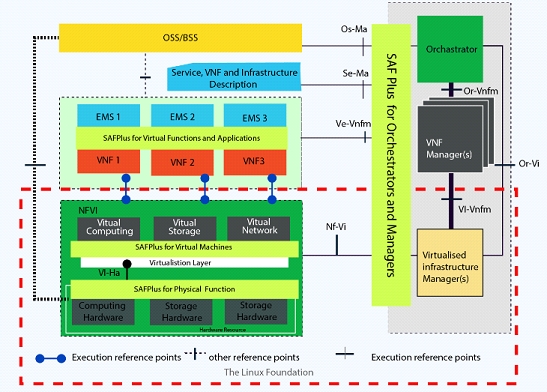That virtualization of Network Functions in carrier networks and data centers being the way forward is given. The market is expected to grow exponentially in the coming years. There are a few key features that is fueling the growth expectations in NFV. Let us examine few of the challenges that they pose with respect to HA.
High Flexibility
Dynamic / elastic scaling of the network is one of the key advantages of using NFV. At the same time, multiple mode of cloud operation, i.e. private, public or hybrid will also determine the same. This, essentially means that a Virtual Network Function (VNF) can be at any physical server, which means that for a cluster of VMs there is no guarantee that they are co-located. Consequently giving rise to the fact that we need an HA system which can support the requirement of sub second detection and response time.
Full Automation
One of the other key features of virtualization is the ability to have full automation and very high levels of programmability of the network function. While, this is a delight for the operator, it poses several challenges of large scale application performance and high amount of processing. Also, this would mean that there would be multiple models of high availability, which would need to be supported and that the models can change dynamically.
Synchronization
In a clustered environment, the synchronization time is one of the key parameters for achieving the goals of reduced latency in bringing up the services in a Hot Standby mode – i.e. zero service disruption. This requires the HA system to have read / write optimizations.
Open Clovis’ SAF Plus has some of the unique features that can address these challenges:
Dynamic High Availability Modeling
This feature enables run-time updates to the HA model. Thus, when new services are dynamically created and new virtual functions, added, the model allows configuration of newer model without affecting the existing services.
Flexible Fault Handing
Different services or application would have different desired behavior in case of a fault. SAFPlus supports a flexible fault-handling capability which can be customized to suite the business need. Also, the fault detection that has been achieved in this solution is in the order of 7 ms, which in turn is much faster than NFV need of 50ms.
Faster Synchronizations
SAFPlus check-pointing extends SAF specifications and implements features like In Memory (RAM based) to meet high performance needs, file based system to allow state data storage that is required to be supported, with the later one resulting in much faster read and write time. A 1024 byte size block can be written under 180 micro seconds using this technique.
SAFPlus as part of the Open NFV architecture
SAFPlus is a very robust middleware for HA, which can achieve HA at multiple layers. It can interwork with orchestration platform like Open Stack to monitor the Compute, Networking and Storage nodes to help achieve HA goals.
SAFPlus can also be a layer on top of the Virtualization Infrastructure and provide Service Availability to individual Network Functions cluster. In this role, SAFPlus can be at Hypervisor layer that monitors the Network Functions.
SAFPlus can also help provide high availability at application layer, i.e. it can be inside the individual virtual machine and monitor the applications


heads the DCT group at Happiest Minds and is responsible for driving strategy, execution, business and technology across the desired market segments. With over 15 years of experience in Networking technologies, Dharmraj’s current areas of interest are SDN and NFV and the co-creation of solutions in this space with OEMs, TEMs, ISVs and ISPs. Dharmraj’s experience includes packet processing on Broadcom, Cavium and other proprietary ASIC and NPU platforms, control stacks from Level 7, GateD, and Nortel Networks proprietary and management plane.







